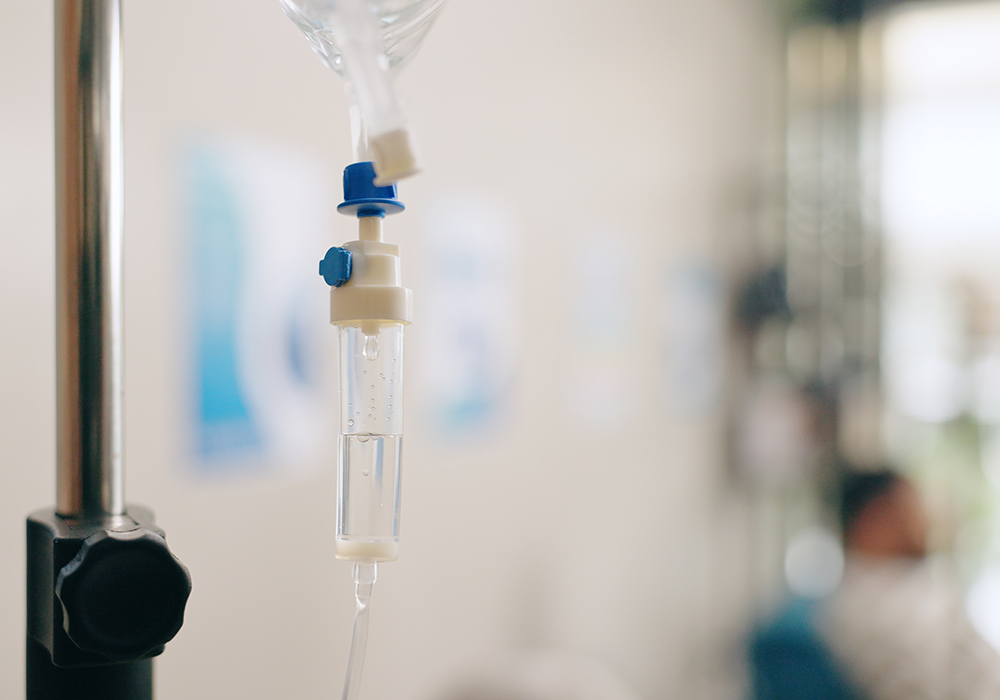| DRUG INFORMATION |
| Classification | Immunotherapy; bispecific T-cell engager |
| Mechanism of Action | Tarlatamab-dlle binds to delta-like ligand 3 (DLL3), which is expressed on the surface of tumor cells, and CD3 expressed on the surface of T cells. This activates T cells and releases inflammatory cytokines, leading to the lysis and death of DLL3-expressing cells. |
| Indications | Treatment of adults with extensive-stage small cell lung cancer with disease progression on or after platinum-based chemotherapy |
| ADMINISTRATION |
| Dosing, Frequency, and Administration | - Tarlatamab-dlle requires step-up dosing and monitoring:
| Cycle | Day | Dose | Monitoring Time | | 1 | 1 | 1 mg | 22–24 hours following the infusion; remain within a 1-hour drive from the healthcare setting for 48 hours following the infusion, accompanied by a caregiver | | 8 | 10 mg | | 15 | 10 mg | 6–8 hours | | 2 | 1 and 15 | 10 mg | 6–8 hours | | 3 and 4 | 1 and 15 | 10 mg | 3–4 hours | | 5 and subsequent | 1 and 15 | 10 mg | 2 hours |
- Infuse all doses over one hour in an appropriate healthcare setting.
- Administer biweekly until patients experience disease progression or unacceptable toxicity.
- Refer to the prescribing information for recommendations to restart tarlatamab-dlle after a dosage delay.
|
| Route | IV infusion |
| Safe Handling | Tarlatamab-dlle is a potentially hazardous drug per the National Institute for Occupational Safety and Health definition. Follow safe handling precautions. |
| ADVERSE REACTIONS |
- Cytopenias: neutropenia, thrombocytopenia, and anemia
- General: fatigue, pyrexia, and musculoskeletal pain
- Hepatotoxicity
- Hypersensitivity reaction during infusion
- Immune system: cytokine release syndrome (CRS)
- Infection, most commonly in the urinary or respiratory tract (e.g., candida infection, pneumonia)
- Laboratory abnormalities: decreased sodium, potassium, and magnesium; increased aspartate amino transferase, alanine aminotransferase, creatinine, alkaline phosphate, and sodium
- Nervous system: dysgeusia and immune effector cell–associated neurotoxicity syndrome (ICANS)
- Respiratory: dyspnea, cough
|
| WARNINGS |
- Black box warnings: CRS and neurologic toxicity, including ICANS
- Other warnings: hepatotoxicity and embryo-fetal toxicity
|
| NURSING CONSIDERATIONS |
| Pretreatment | - Before each dose, monitor blood counts, liver enzymes, and bilirubin, and observe for signs and symptoms of infection.
- Assess for pregnancy prior to treatment.
- Monitor for signs and symptoms of infection.
- Pre-medicate with dexamethasone IV within 1 hour of administration on cycle 1, days 1 and 8.
- Step-up dosing followed by monitoring is recommended to reduce the risk of CRS and ICANS.
|
| Administration | - Monitor for hypersensitivity reaction.
- Collaborate with pharmacy to ensure that the drug bag and tubing used for compounding and administration are compatible with tarlatamab-dlle.
|
| Post-Treatment | - Administer 1 L of normal saline via IV over 4–5 hours immediately after completion of infusion on cycle 1, days 1, 8, and 15.
- Patients should remain within a one-hour drive from the healthcare setting for 48 hours after infusion on cycle days 1 and 8.
- Monitor for signs of CRS, including fever greater than 100.4°F, hypotension, and hypoxia.
- Monitor for signs of ICANS, including somnolence, depressed level of consciousness, and seizures.
- For patients experiencing grade 2 or higher CRS, monitor with continuous cardiac telemetry and pulse oximetry.
- Conduct laboratory testing (i.e., complete blood counts, liver function tests, and chemistries) as indicated.
|
| PATIENT EDUCATION |
- Report signs and symptoms of CRS, including fever, low blood pressure, headache, fatigue, nausea, and vomiting.
- Report dizziness, confusion, tremors, sleepiness, or other neurologic symptoms. Do not operate heavy machinery or engage in any dangerous activities while under treatment.
- Report signs of infection, such as a fever higher than 100.4°F, cough or shortness of breath, painful urination, or generally feeling unwell.
- Advise patients of reproductive potential to use effective contraception during treatment and for two months after the final dose. Do not breastfeed/chestfeed during treatment and for two months after the final dose.
- Most common side effects include a metallic or bad taste, decreased appetite, muscle or bone pain, constipation, and nausea.
- Stay within a one-hour drive of the healthcare setting for 48 hours after the first two doses.
- Laboratory testing will be needed.
|
| RESOURCES |
| Patient Resources | |
| Healthcare Professional Resources | |
| Other Resources | |






